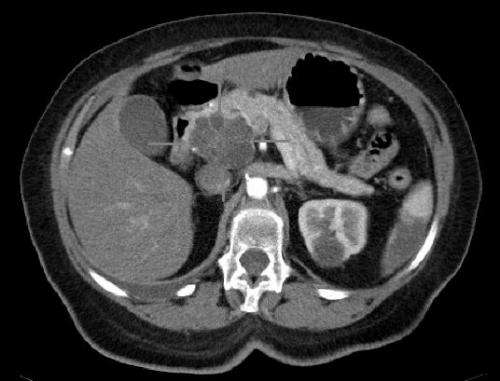Axial CT image with i.v. contrast. Macrocystic adenocarcinoma of the pancreatic head. Credit: public domain
The research team led by Prof. Yang Lihua from Hefei National Laboratory for Physical Sciences at the Microscale, School of Chemistry and Materials Science of the University of Science and Technology of China (USTC) of the Chinese Academy of Sciences proposed nanomicelles composed solely of macromolecules as a new approach for treating pancreatic tumor. The study was published in ACS Applied Materials & Interfaces.
Host dense peptide (HDP) is a part of the innate immunity of eukaryotic organisms. It helps the host fight back attack by microbes through disrupting cellular membrane integrity. Inspired by HDP, membrane-disruptive macromolecules are designed with HDP's two most common structural characteristics (cationic and amphipathic) to realize similar membrane-disrupting functions so that drug-resistant cancer cells can be efficiently eliminated. The onset of drug resistance is delayed after repeat treatment, suggesting the potential for addressing the cancer resistance issue.
Despite these advantages, membrane-disruptive macromolecules normally cannot distinguish cancerous from normal cells. How to make membrane-disruptive macromolecules preferentially active to cancerous cells over normal cells is a significant challenge.
In this study, the researchers used an acid-sensitive, membrane-disruptive micelle (M-14K) as the model for such nanoparticles.
This long-circulating nanoparticle showed acid-activated cytotoxicity indiscriminately to both cancerous and fibroblast cells, which is realized by acid-activatable disruption of cellular membrane integrity. The ability of such nanoparticles to penetrate the stromal barrier and eliminate the sheltered cancer cells was verified both in vitro using three-dimensional (3D) cell spheroids and in vivo using mouse models bearing BxPC-3 tumors.
Notably, through animal experiments, the researchers found that the expression of extracellular matrix components was significantly suppressed, the tumor tissue was transformed into a less dense structure, and stroma was remodeled, without promoting tumor metastasis.
Using acid-responsive nanoparticles composed solely of membrane-disruptive macromolecules, stroma remodeling and cancerous cells elimination can be realized simultaneously. This approach may open a new avenue for the development of efficacious drugs inhibiting pancreatic tumor growth and metastasis.
What makes pancreatic tumor hard to cure is the dense stromal barriers sheltering cancerous cells. The penetration of drugs is hindered. To promote the infiltration of therapeutics, an adjuvant is used prior to gemcitabine to remodel the stroma. Nevertheless, this widely studied strategy may raise the risk of tumor metastasis and tumor cells' resistance to drugs.
More information: Feng Fan et al, pH-Sensitive Nanoparticles Composed Solely of Membrane-Disruptive Macromolecules for Treating Pancreatic Cancer, ACS Applied Materials & Interfaces (2021). DOI: 10.1021/acsami.0c16576
Journal information: ACS Applied Materials and Interfaces
Provided by University of Science and Technology of China
























